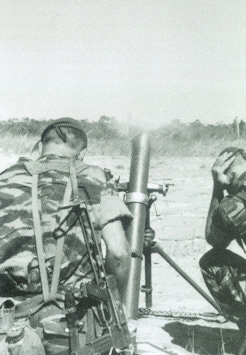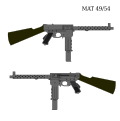| Pistolet-Mitrailleur de 9 mm modèle 1949 (MAT-49) | |
|---|---|
 MAT-49 on display. This weapon has the front grip lowered in firing position, but lacks a magazine. | |
| Type | Submachine gun |
| Place of origin | France |
| Service history | |
| In service | 1949–Present |
| Used by | See Users |
| Wars | First Indochina War Korean War Suez Crisis 1958 Lebanon Crisis Algerian War Vietnam War Laotian Civil War Cambodian Civil War Sino-Vietnamese War Portuguese Colonial War Basque conflict Rhodesian Bush War Western Sahara War Shaba II Chadian–Libyan conflict Lebanese Civil War Algerian Civil War Libyan Civil War [1] Syrian Civil War Northern Mali conflict [2] Central African Republic Civil War (2012–present) [3] |
| Production history | |
| Designer | Pierre Monteil |
| Designed | 1947-1949 |
| Manufacturer | Manufacture Nationale d'Armes de Tulle Manufacture d'armes de Saint-Étienne |
| Produced | 1949–1973 |
| No. built | ~ 100,000 |
| Variants | See Variants |
| Specifications | |
| Mass | 3.5 kg (7.7 lb) without magazine 4.2 kg (9.3 lb) with 32-round magazine |
| Length | 460 mm (18 in) 720 mm (28 in) |
| Barrel length | 230 mm (9.1 in) |
| Cartridge | 9×19mm Parabellum 7.62×25mm Tokarev (PAVN converted) |
| Caliber | 9mm |
| Action | Blowback, open bolt |
| Rate of fire | 600 rounds/min [4] |
| Effective firing range | 100 m (110 yd) |
| Feed system | 20 or 32 rounds 35 rounds (PAVN converted) |
| Sights | Iron sights |
The MAT-49 is a submachine gun which was developed by the French arms factory Manufacture Nationale d'Armes de Tulle (MAT) for use by the French Army. It was first produced in 1949 and remained in French service until it was phased out following the adoption of the FAMAS assault rifle in 1979.




